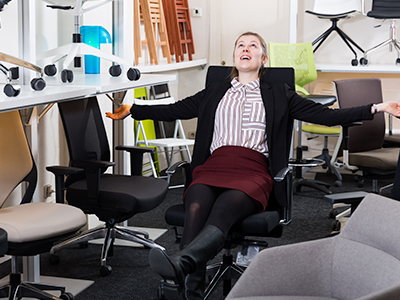Picking the Right Ergonomic Chair

Find the Best Ergonomic Chair for You
During a standard week, employees may sit in their desk chair for up to 40 hours a week. For many of us, that’s not far off from the amount of time we spend asleep or in our beds. The importance of a good ergonomic chair is often overlooked by both employers and employees alike, but E3 Consulting knows that everything from productivity to comfort is at risk when poorly-designed seats are involved. Whether you’re looking to refurnish your company’s building, buy a chair for at work, or even picking a new seat for your in-home office, the following information will help decide what to look for when finding the best ergonomic chair for you.
What to Look For
Searching for an ergonomic chair that works for you is no lighthearted adventure. If you’re not sure what to search for, don’t worry! E3 Consulting has listed all of the top features to look for when shopping for your new chair.
Adjustability
The number one thing to look for in an ergonomic chair is adjustability. The more a chair is adjustable, the better. While many office chairs have height and arm adjustments, a good ergonomic chair goes beyond that. Some chairs have up to 14 different adjustments! Adjustments include the seat height (also referred to as chair height), seat width, seat depth, seat tilt, back support, backrest recline, swivel, armrests, headrest, tension control and more.
Wheeled Base
Having a chair with wheels may seem inconsequential, but they are necessary. Especially in offices with cubicles or large desks, reaching across a table multiple times a day can create strain. Rolling allows employees to keep every item within reach due to the mobility of their seat. Moreover, a chair that turns, swivels, and rolls with ease reduces the effects being stationary at a desk, and employees are able to turn their whole body to view documents, multiple monitors, calendars, and more.
Lumbar Support
The adjective “lumbar” refers to the lower spine and area of the back within its proximity. Proper ergonomic chairs have support for the lower back, which helps prevent back strain, pain, stiffness, and stress. When chairs lack lumbar support, the resulting pain can reduce productivity. Additionally, any lumbar support should be adjustable to any user, as no one person has the same alignments of hips or pelvis.
Comfort
It almost goes without saying, but a good ergonomic chair is comfortable. Much like beds, the best chair isn’t always the one that is the most plush, or offers something to “sink” into. Often, furniture of this nature results in poor posture, and can sag, dip, and compress over time. The most comfortable chairs are ones that provide all of the above ergonomic features. Having a flexible, breathable fabric along the back of the seat also increases comfort, as well as reduces the entrapment of heat. When testing chairs, the goal is to find one that feels so natural to sit in that it nearly disappears, with sitting in the best chairs being likened to “floating.”
Contact E3 for a Consultation
As you can see, searching for the best chair within size, price, and comfort restraints can be tough! Luckily, the specialists at E3 Consulting are always ready to help make your workplace all that much better when finding a chair, or any other ergonomic device. Through personally-designed and tailored ergonomic programs, individuals and companies can experience a more productive and comfortable work environment. Contact us today to learn more about our variety of services, or take our online pre-evaluation survey.

